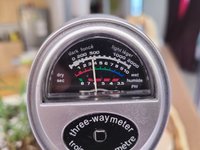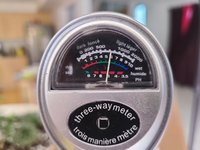A couple points.
First, if you are getting water from a municipal system, call the police, the EPA, and your local Health Department if the water coming out of your tap is less than pH 7.8 because they are trying to kill you with lead poisoning. Municipal water MUST be buffered to pH 7.8 to 8.5 to prevent lead leaching out of pipes, and brass fixtures into your drinking water. The City of Flint, MI lead poisoning event was caused by the City of Flint switching water supply and not sufficiently buffering the water pH to a level above 7.8. As a result thousands of children of Flint now are dealing with the mental retardation and behavior effects of low level lead poisoning. So if your tap water has a pH below 7.8, don't rejoice for your plants, panic for your children, or grandchildren. If you are on a private well, check the history of your supply lines. Make sure you have no lead pipes, and if you have copper pipes, that the solder used was lead free. Your personal health is more important than your trees.
Second. Relying on pH is a fool's errand without understanding the total alkalinity of your water. Total Alkalinity is a measure of the buffer capacity of your water. Low total alkalinity, a measure of buffer capacity, means pH is very easy for plants to regulate without human assistance. High total alkalinity, means it is difficult for plants to regulate the soil pH, and you will have to use large amounts of chemicals to lower your pH.
Best way to get your water chemistry is to get a copy of the yearly water reports all local municipalities are required to make public. In USA a test lab will do a complete analysis for around $125 or just Total Alkalinity test as a single test runs about $40. 2 most important tests are Total Alkalinity and Total Dissolved Solids, pH is a less important test.
If your Total Alkalinity is less than 125 mg/liter as calcium carbonate, also written as 125 ppm as calcium carbonate, if your Total Alkalinity is below this level, your water is soft to medium on the hardness scale and you have absolutely no need to worry about pH. Your plants will be able to buffer the soil with their own roots and you simply don't have to worry. Unless you are growing real sensitive carnivorous plants. As an approximation total dissolved solids of 150ppm or less will indicate that your total alkalinity will be less than 125 ppm as calcium carbonate. If tests are performed correctly Total Alkalinity will ALWAYS be less than Total Dissolved Solids. TDS is always written as parts per million, the units remain the same when converted to milligrams per liter as long as you are talking about water solutions.
Medium hardness water is total alkalinity of 125 mg/liter to roughly 600 mg/liter, in this range water is considered "acceptable" for landscape nursery use. You can compensate for the higher calcium content of the water by use of acidic fertilizers, and choosing potting media components to help the plants buffer their root zones to the proper growing range. Here using bark, and or peat moss as a component of your potting mix will help reduce the total alkalinity. Top dressing potting mix with elemental sulfur will help reduce alkalinity. Collecting rain water, in areas with regular rain will help. Eastern half of North America, collecting rain is actually quite practical. I collect enough rain with half a dozen open 3 gallon pails, scattered around the back yard, I then empty them after a rain into a 55 gallon open top barrel. I can keep the barrel at least half full for most of the year. I rarely have to use "tap water".
Hard water is above 600 mg/liter as calcium carbonate or over 650 ppm total dissolved solids. Only here do you really need to think about using various methods such as RO or DI water. If your water comes from a well, that is in a limestone aquifer, you might be in this situation.
I wrote quite a bit more, but I am tired of typing. Search posts in threads on pH and look for posts by me.
@LemonBonsai - you are in Ontario, Canada, that is on the Laurentian Shield, your bedrock should be granite. You should have fairly low total dissolved solids for your municipal water. I doubt that you should be needing to worry about your water pH.





